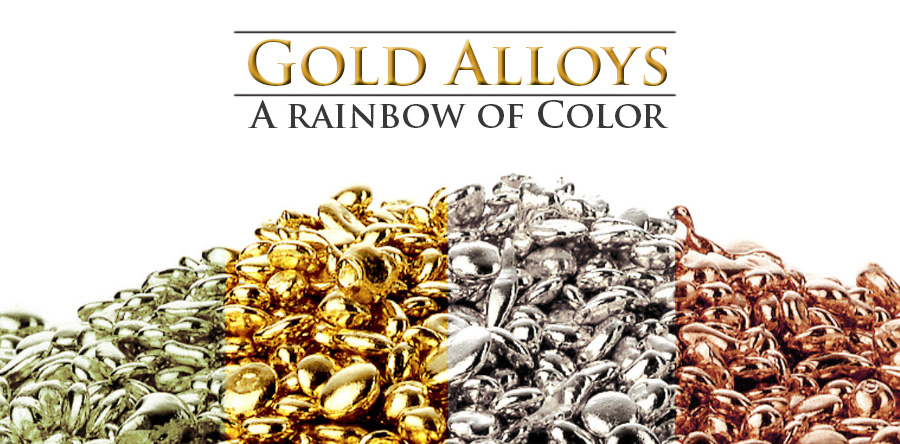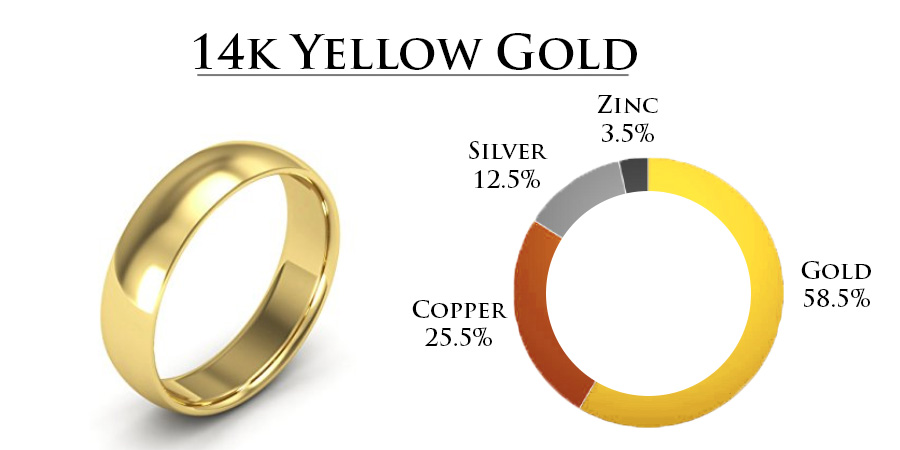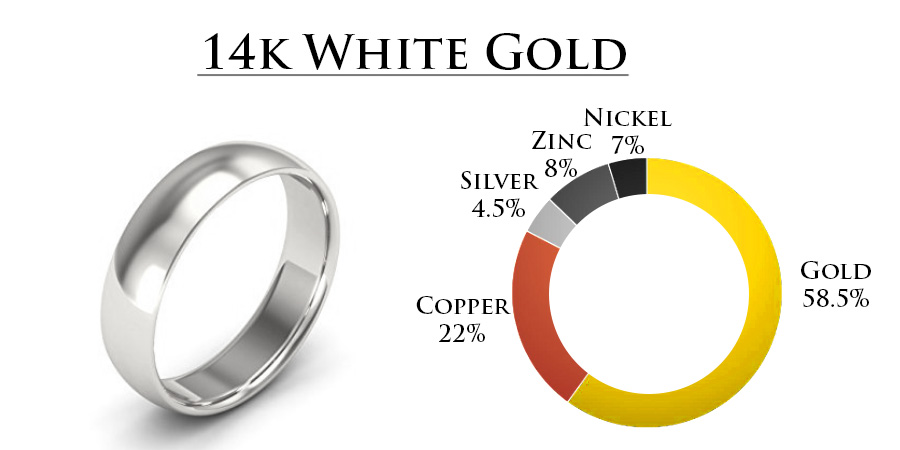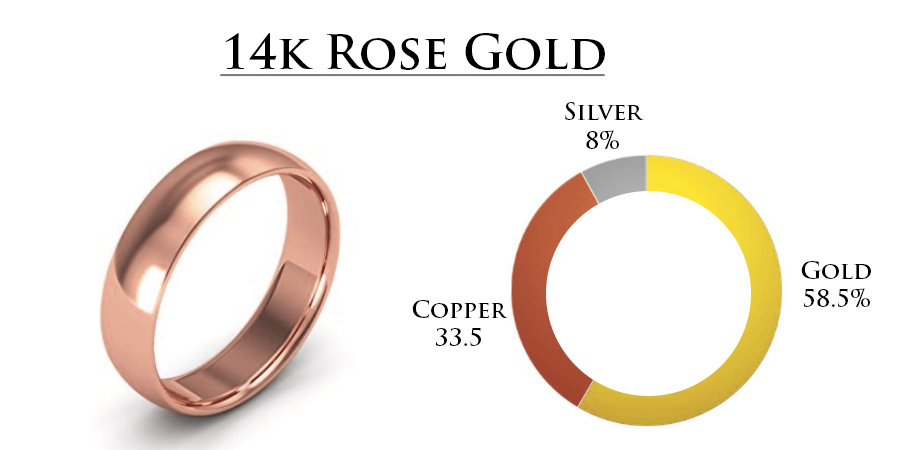A few weeks ago, we had an in-depth conversation about the gold mining and refining process. Part of that discussion focused on the alloying process. Alloying gold is the process through which different metals are added to pure gold. We alloy gold for different reasons. Gold, in its pure form, is quite soft. To combat that relative softness (I say relative because, after all, we are talking about metal. It’s not as though it’s as soft as a pancake or something), we can add different metals. But increasing the strength and hardness of gold isn’t the only reason we alloy it. By adding different metals in various amounts, we can also alter the color of the metal.
Yellow gold is fairly simple. The industry standard in the United States is generally regarded as 14 karat. However, in Europe, the standard is 18 karat. Side-by-side, the naked eye can tell the color difference between the two varieties. Fourteen karat is obviously yellow in a very sunny and beautiful way. But 18 karat has a deeper and brighter tone. So why the difference? How does the alloying process affect the color?
Twenty-four karat gold is a deep, vibrant, slightly orange-y yellow. But since no other alloy metals have that color, no matter what we alloy gold with, the yellow color is going to get toned down. Eighteen karat preserves quite a bit of that yellow hue, since 18 karat gold is 75% gold. The remaining 25% is commonly comprised of copper (14%), silver (10%) and zinc ( 1% ). The redness from the copper helps balance out the bright whiteness of the silver, the zinc is added for fluidity during casting. The resulting 18 karat yellow gold is a rich yellow color, but it doesn’t have quite the orange-y depth that 24 karat does. Additionally, adding copper and silver to the gold helps increase its hardness and strength, making 18 karat gold a great candidate for jewelry, especially for the person who loves the richness of the yellow color of gold (like me).
As you have probably assumed, or experienced, 18 karat gold is more expensive than the standard 14 karat owing to its high gold content. For this reason, many people opt for 14 karat gold. Fourteen karat yellow gold is not quite as bright yellow as 18 karat, but it still retains a lovely yellow color. Fourteen karat gold is comprised of 58.5% gold, 25.5% copper and 12.5% silver and 3.5% zinc. Fourteen karat gold is slighter harder than 18 karat, but not enough that its use in jewelry is affected.
So how about white gold? White gold is almost a misnomer, considering it is still a pale yellow. At the end of the day, we’re still working with gold, which is a dark yellow. No matter how much white metal alloy you add, you are still going to end up with a very pale yellow color. Fourteen karat white gold is the standard, although it can also be made in 18 karat. Fourteen karat white gold is 58.5% gold, 22% copper, 7% nickel, 8% zinc, and 4.5% silver. Some people with significant nickel allergies may prefer to opt for a white gold alloy that uses some palladium (58.5% gold, 21% silver, 15.5% palladium 4% copper and 1% zinc). Some alloys also may do without any copper by adding more palladium, although adding more palladium makes the gold harder and more difficult to work with. However, there is another important consideration with regard to white gold: rhodium. Rhodium is an extremely expensive, bright white metal that is electroplated onto white gold jewelry to give the white gold that bright and shiny white look that we expect. Rhodium is hypoallergenic, so even if someone is sensitive to nickel, there generally isn’t a need to buy the nickel-free white gold alloy. Just make sure you keep your plating in good condition. Expect to have your rhodium plating redone every six to 12 months, depending on the wear and tear your jewelry takes.
Now on to my personal favorite: rose gold. I honestly can’t imagine why it took so long for rose gold to have it’s time in the spotlight. I would like to casually mention that although it’s only been recently that the rest of the fashion world has caught on to the rose gold craze, I have been an ardent admirer of rose gold for a number of years. Rose gold differs from yellow or white gold because instead of trying to retain or downplay gold’s natural yellow color, alloying to create rose gold seeks to actually change the color of the metal. To create 14 karat rose gold, we start with 58.5% gold. Then a small amount of silver is added (8%) and the balance is copper (33.5%). It is the high amount of copper that gives rose gold its signature reddish-pink yellow color.
Interestingly, pink gold, red gold, and rose gold all fall under the rose gold umbrella. However, they are distinct alloys. You can make the metal lighter and less red by reducing the amount of copper. This would give a more pink color, instead of the rose. For red gold, less silver but more copper will yield a more reddish hue.
Another less known alloy is green gold, mixed generally with only silver, the gold gets a greenish tint to it. For 18kt 75% gold and 25% silver. This works very well with enameled pieces where the enamel adheres strongly to the mixture of only precious metals in green gold. Green gold pairs well with some precious gems like sapphire and rubies.
Compared to white or yellow gold, rose gold is malleable (because of the amount of copper in it). While this sounds great for the consumer, note that you should seek out an experienced jeweler (like the ones in our downtown Brighton showroom) for work on your rose gold jewelry, since rose gold’s special properties depending on the amount of silver into it, can be a little more difficult to work with.
Everyday, we blend science and art. We can take precious metal, mined from rock but still too soft to weather the active lives of society today, and blend it with other metals to produce myriad gold options. The results are a rainbow of colors, a variety of possibilities, and an endless supply of fodder for the imaginations of jewelers.
Until next time,
Rebecca








